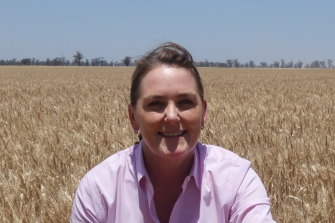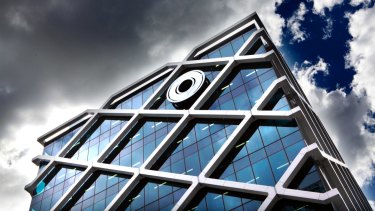Why Macquarie is looking to pump billions into farms
It’s 35 degrees, the flies are out in force and five enormous, high-tech machines are working their way through a golden wheat field in southern NSW.
Combine harvesters, 12-metre-wide tractor-like contraptions, motor over a 400-hectare paddock that was once a family-owned farm, harvesting wheat that could be used in bread, noodles or biscuits.

With gusts of wind getting stronger, farmers watching on say it won’t be long until the harvest is shut down for the day, because the risk of sparking a fire is too high.
It is not the sort of environment you would generally associate with the slick world of investment banking.
Yet this paddock, near Albury, is on the front lines of Macquarie Group’s attempt to harness billions of dollars in global capital and pump it into corporate-run farms.
Leading this push – and straddling the worlds of high finance and farming – is Elizabeth O’Leary, head of agriculture at Macquarie Infrastructure and Real Assets.
‘The individual farmer would typically bring their family equity and bank debt… We can bring a new source of capital into the sector.’
Elizabeth O’Leary, head of agriculture at Macquarie Infrastructure and Real Assets
After growing up on a farm about 120 kilometres away from this one, O’Leary has spent the past five years building up Macquarie’s agriculture business, which now manages $2.7 billion in assets, producing everything from avocados to beef.
“The individual farmer would bring their family equity typically and bank debt, and that’s their capital base. We can bring a new source of capital into the sector,” she tells The Sydney Morning Herald and The Age on a recent trip to the region.
The pitch is that global capital can provide the scale and firepower required to finance the farming techniques needed to feed a growing world population, while also making farming more environmentally friendly.
Macquarie, which has invested its own capital, charges a fee for managing the assets.
Why farming?
It is similar to the model that helped make Macquarie a powerhouse in the financing of infrastructure, in which it is the world’s biggest asset manager. Whether the group, known as the millionaires’ factory, can pull off the same financial feat in farming remains to be seen.
About an hour’s drive away from the wheat paddock is one of the nerve centres behind Macquarie’s farming push.
In Albury, staff in the offices of Macquarie-owned Viridis Ag can monitor the operations in minute detail, such as the latest yield or the fuel consumption of one of the combine harvesters working the field. On the wall is a map of Australia, with coloured pins representing the farming operations run by Macquarie-owned businesses.
The portfolio includes avocados, various other crops, cattle and a 49 per cent stake in the country’s largest cotton farm, Cubbie Station.
Perhaps the most obvious question is what has prompted Macquarie to get into the farming business? And how are its farms going in one of the worst droughts on record?
Despite the extreme conditions, O’Leary says there remains strong demand from big investors, especially from overseas, to own Australian farms. Some of its investors have pledged to lock up their capital for 15 years and O’Leary stresses that over longer time frames, farmland is a “highly defensive” asset.
“If you look at all the data, returns in agriculture are uncorrelated with anything, so it’s just a classic diversification story,” she says.
Farming is volatile due to factors such as drought but Macquarie aims to limit volatility by spreading capital across a range of different types of farms, in various climate zones across the country.
“For us it’s about how do we smooth out the volatility with these big diversified portfolios and then how do we maximise the opportunity for capital appreciation in the underlying land value by treating it well,” O’Leary says.
O’Leary says it has been “a really tough year across the board,” due to the lack of rain. The geographic mix of farms has helped, but not as much as it normally would.
The financial logic is also underpinned by expectations that global food supply must increase sharply to feed a growing population, and investors are also betting returns can be lifted by improving farming methods and improving soil health.
‘When funds look around the world at risk-weighted returns and an opportunity assessment, Australia fares very favourably.’
Elizabeth O’Leary
Domestic superannuation funds have a small allocation to agriculture, with Australians only making up about 15 per cent to 20 per cent of the investors in these funds. But O’Leary says overseas funds, including those in Europe, have a history of backing the sector.
“When those funds look around the world at risk-weighted returns and an opportunity assessment, Australia fares very favourably,” she says.
The executive comes to the job with hands-on experience in farming. She is one of seven daughters who grew up as rice, wheat and sheep farmers in the Riverina region.
O’Leary, who is married and has two daughters, has been at Macquarie for more than 16 years. During that time she was closely involved in the 2009 purchase of US funds management business Delaware Asset Management, European infrastructure deals, and, before this job, she was the global head of human resources.
Growth ambitions
“I’ve got two very different wardrobes,” O’Leary says. “And I just have to make sure I pack the right one, because I’m not sure how New York would cope with these dusty boots.”
For institutional investments in farming to stack up, the operations have to be large scale. This will mean buying up more family farms around the country.
The entities controlled by Macquarie have already snapped up dozens of farms and more expansion is on the cards. “We continue to want to build out our portfolio with high-quality assets,” O’Leary says.
As you would expect, however, the investment banking group’s expansion has attracted scrutiny.
There has been criticism from some about land clearing. A neighbour of one of the Macquarie farms near Cootamundra, in NSW, this year told the ABC he was “gobsmacked” when the new owners bulldozed native trees on the property.
O’Learly responds that Macquarie will replace any trees that are removed by planting even more elsewhere. Even so, she concedes there is a “natural tension” between the global need to ramp up food production and managing environmental impacts.
“It’s not ideal, it’s not perfect. It’s trying to find this compromise between productivity and managing the environment and biodiversity,” she says.
There are also regulatory hurdles.
O’’Leary says the Foreign Investment Review Board is required to approve each acquisition the funds she manages make in Australia, which could have “unintended consequences” for those selling their farms.

“It [the process] is lengthier than it was intended to be. We just need to be mindful with this kind of process that it does not act as a competitive disadvantage,” O’Leary says.
As part of her pitch, she argues the wave of investment and the employment opportunities can revitalise rural communities.
“I think there’s a view that families disappear from farms, and actually, if anything, what’s happened in our business is you’ve seen the natural retirement of families and the replenishment of those communities with typically young couples with kids,” O’Leary says.
The wider environmental challenges facing farmers also loom large.
Food production contributes to 10 to 12 per cent of the world’s greenhouse gas emissions, and O’Leary admits the sector faces a “conundrum”.
“You’ve got an imperative to double food production globally. We’ve got to reduce our use of water … And we’ve got to curb the CO2 emissions profile.”
Even so, she argues that moves to cut emissions and pursue more sustainable farming practices will improve profitability.
Promoting soil health on the wheat farms near Albury, for example, should over the long-term improve yields from the land. GPS-guided harvesters that have their movements tracked should also emit less pollution and be less expensive to run.
In a boost for these plans, the taxpayer-owned Clean Energy Finance Corp last year tipped in $100 million to be managed on MIRA’s agricultural business, targeting energy efficiency on farms.

Some in the industry are yet to be convinced. One Western Australian farming group this year questioned if the CEFC’s investment was a subsidy for methods that are already being adopted elsewhere.
Macquarie, meanwhile, says that it is codifying the farming practices of the top quartile and rolling them out at scale. In a sign of the strong demand for these sorts of assets among institutional investors, one of its unlisted agriculture funds recently raised another $1 billion.
It is this goal of bringing in large-scale capital for farming investment that O’Leary describes as the “so what?”.
“Because we’ve been able to find the right people and build these cohesive scaled units, we can bring institutional capital in at a size and a scale with the right sort of processes and governance around it that gives them comfort this is an investable asset class,” she says.
Farms may not be what most people imagine when they think of Macquarie.
But the financial group clearly believes there is a growing appetite among large global investors for a slice of Australia’s agricultural wealth.
Clancy Yeates is a business reporter.
Most Viewed in Business
Source: Thanks smh.com